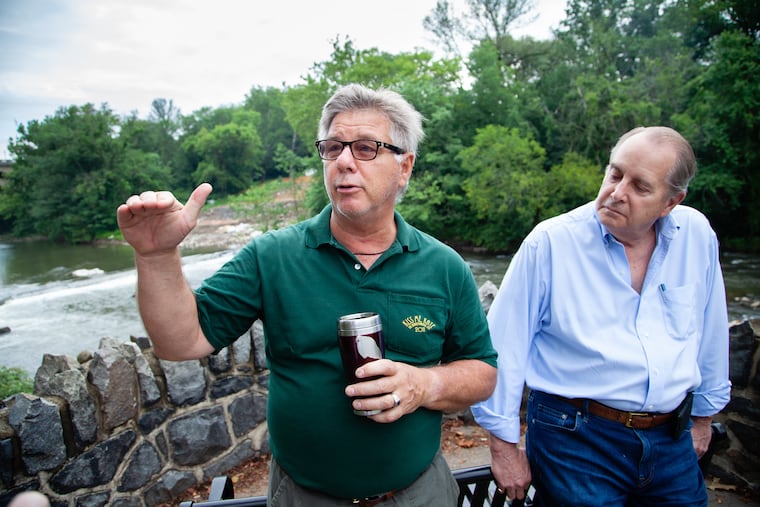For 300 years, Philly’s ‘founding fish’ has been missing from the Brandywine. Meet the folks trying to bring it back | Mike Newall
An unassuming fish trapped in the hinterlands of Delaware is a symbol of the natural beauty of our region – and what we’ve done to it, and what we can do to restore it.

I stood less than 10 miles from the Pennsylvania state line, watching the mighty rapids of the Brandywine River fade — ebb and pool against the dam blocking one of the most historic rivers in the country. Somewhere below the surface of the West Street Dam in downtown Wilmington, my companions assured me, schools of shad — the founding fish! — have been bumping their poor noses against a man-made barrier for nearly three centuries.
Like many Pennsylvanians who leave our fine state, the shad just want to come home.
But for almost exactly 300 years, the fish that fed Native Americans and colonial settlers, too, has been stuck in Delaware. That’s thanks to — you guessed it — a white guy looking to line his pockets, who threw up the first dam across the Brandywine in 1720, and put in a mill, to boot.
It’s your basic American disenfranchisement story. As the shad bumped into the dam, Native Americans across the border who had relied on the fish for centuries eventually petitioned the local government: the dam, and the loss of their fishing rights, made it impossible to feed their people. Their pleas fell on deaf ears. They were forced to move to Western New York.
That injustice was ecological, too. It turned a natural place into a man-made center of enterprise. The mills that opened along the Brandywine powered the Industrial Revolution to the steel mills of Coatesville and beyond — and, along the way, shut out the shad.
Why my sudden interest in this unassuming fish trapped in the hinterlands of Wilmington? Because, in its shad way, it’s a symbol of the natural beauty of our region —and what we’ve done to it, and what we can do to restore it. But it’s also because of the passion of Jim Shanahan and Hunter Lott, who have made it their life’s goal to liberate the shad, to allow them to swim freely up to their ancestral spawning grounds.
>>READ MORE: Scientists’ goal: Make the rare American shad less rare
Shanahan and Lott were the ones who took me to the dam Thursday. They’re the founders of Brandywine Shad 2020, a group working to remove 11 — eleven! — dams in the Brandywine that stretch from Delaware to the Pennsylvania line.
Like all good things, the idea was inspired by Philadelphians. OK — if not inspired, reinvigorated, perhaps. There had been slow, scattered efforts to pull the damned dams down. (Allow me this.) Then Lott read, in this column, a story about a couple of aquatic biologists and scientists at the Philadelphia Water Department who built their own shad hatchery in the Schuylkill, trying to restock its slow-growing shad population. And they were doing it with spare parts and a shoestring budget.
(“Hearing that your work gets carried on is exactly why you’re out there doing what you’re doing,” said Joe Perillo, Water Department staff scientist, when I told him how his makeshift hatchery had encouraged the Delawareans.)
An ordinary person might read that story and think, Cool. Hope the shad come back. Lott, a retired real estate broker with experience in historical conservation, thought, Time to get to work.
He and Shanahan assembled a cohort of conservancy heavyweights, including scientists from the Water Resources Center at the University of Delaware and officials from the Hagley Museum and Library in Wilmington and the Brandywine Conservancy in Chadds Ford. In March, the group won a $241,000 grant from the U.S. Fish & Wildlife Service. With matching funds from the state in hand, they hope to raise enough to have the Delaware dams down by the end of 2020.
That would leave at least four dams on the Pennsylvania side of the border. And the Pennsylvania Fish & Boat Commission told me they would be willing to take a hard look at getting rid of those if Lott and Shanahan can uncork the plug in Delaware.
For now, on the banks of the Brandywine, Shanahan talks about the project in reverent terms. “This is God’s work,” he says — returning a river to its natural state.
Spend enough time with Shanahan and Lott, and you come to feel the same way, too — walking by the river that still pushes its way from the steel towns to the sea, and imagining my dam buddies’ delight if it were fat with shad.